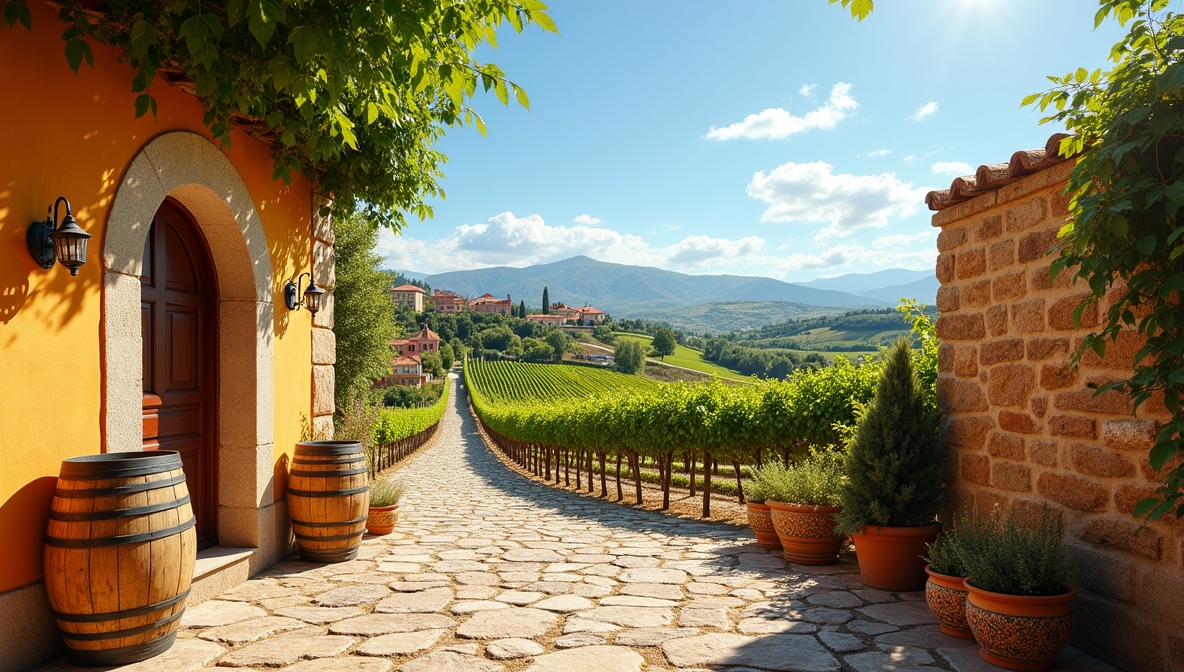
Spain holds one of the richest winemaking traditions in the world, with landscapes that shift from rolling vineyards to rugged hills. Each region produces wines with distinct character, shaped by climate, soil, and time-honored techniques. From the bold reds of Rioja to the fortified wonders of Jerez, Spain’s wine regions offer an unmatched variety of flavors.
1. Rioja – The Heart of Spanish Wine
Key Wines: Tempranillo, Garnacha, Graciano, Mazuelo
Best for: Bold, oak-aged reds with depth and structure
Rioja stands as Spain’s most recognized wine region, known for its structured red wines that often carry notes of dark fruit, vanilla, and spice. Tempranillo takes center stage, blending harmoniously with other native grapes. Winemaking here follows strict classifications:
- Joven – Fresh and fruity, aged less than a year
- Crianza – Minimum of two years aging, with at least one in oak
- Reserva – Aged at least three years, including one in oak
- Gran Reserva – Five years of aging, with a minimum of two in oak
Wines from Rioja Alta and Alavesa tend to be more refined and elegant, while those from Rioja Oriental lean towards richer, fruit-forward expressions.
2. Ribera del Duero – Powerful Reds with Elegance
Key Wines: Tempranillo (locally called Tinto Fino)
Best for: Deep, full-bodied reds with intense structure
Located along the Duero River, Ribera del Duero produces some of Spain’s most prestigious red wines. The region’s extreme temperature shifts create wines with deep color, firm tannins, and concentrated flavors of blackberry, plum, and tobacco. Many of Spain’s top wineries, including Vega Sicilia, hail from this region, crafting wines with remarkable aging potential.
3. Priorat – Spain’s High-Elevation Gem
Key Wines: Garnacha, Cariñena, Syrah
Best for: Rich, mineral-driven reds with depth
Nestled in Catalonia, Priorat stands apart due to its unique slate soil, known as llicorella, which forces vines to grow deep in search of water. This struggle results in intensely concentrated wines, often displaying dark fruit, licorice, and smoky minerality. Priorat’s wines are known for their bold structure and long aging potential, often ranking among Spain’s most collectible bottles.
4. Rías Baixas – The Home of Albariño
Key Wines: Albariño
Best for: Crisp, aromatic white wines with refreshing acidity
Rías Baixas, located in Galicia along Spain’s northwestern coast, is famous for producing some of the country’s finest white wines. Albariño thrives here, benefiting from the region’s Atlantic influence. Wines are typically bright and citrusy, with notes of peach, green apple, and salinity, making them perfect for seafood pairings.
5. Jerez – The Land of Sherry
Key Wines: Palomino, Pedro Ximénez, Moscatel
Best for: Fortified wines with layers of complexity
Jerez, located in Andalusia, produces Spain’s world-renowned Sherry. The region’s warm climate and albariza soil create optimal conditions for Palomino grapes. Sherry styles vary widely:
- Fino & Manzanilla – Light, dry, and saline-driven
- Amontillado & Oloroso – Nutty, complex, and richer in body
- Pedro Ximénez & Moscatel – Dark, intensely sweet, and raisin-like
The solera aging process adds depth, making these wines some of the most complex in the world.
6. Penedès – Spain’s Sparkling Wine Capital
Key Wines: Xarel·lo, Macabeo, Parellada
Best for: Traditional-method sparkling wines (Cava)
Penedès is best known for producing Cava, Spain’s answer to Champagne. Using traditional methods, Cava is crafted primarily from native grapes like Xarel·lo, Macabeo, and Parellada, yielding crisp sparkling wines with green apple, citrus, and brioche notes. The region also produces excellent still wines, including vibrant reds and aromatic whites.
7. Toro – Bold and Intense Reds
Key Wines: Tinta de Toro (Tempranillo)
Best for: High-alcohol, deeply concentrated reds
Toro, located in Castilla y León, produces some of Spain’s most robust red wines. With old, ungrafted vines and low yields, the wines exhibit deep color, powerful tannins, and bold flavors of black cherry, spice, and dark chocolate. Many winemakers embrace a modern approach, balancing intensity with finesse.
8. Bierzo – The Rising Star of Mencía
Key Wines: Mencía
Best for: Elegant, aromatic reds with freshness
Bierzo, tucked into northwest Spain, has gained attention for its Mencía-based wines. The grape produces medium-bodied reds with floral, red berry, and mineral-driven characteristics. The region’s cooler climate helps maintain acidity, making these wines vibrant and highly expressive.
9. La Mancha – Spain’s Largest Wine Region
Key Wines: Tempranillo (Cencibel), Airén, Garnacha
Best for: Affordable wines with excellent value
La Mancha spans a vast portion of central Spain and is the largest wine-producing region in the country. It’s known for producing wines at various price points, including high-quality Tempranillo reds and fresh, citrusy whites from Airén. The region also sees a growing number of organic and sustainable winemaking initiatives.
10. Montsant – The Neighbor of Priorat
Key Wines: Garnacha, Cariñena
Best for: Full-bodied reds with Mediterranean character
Often compared to Priorat, Montsant offers similarly bold and mineral-driven wines but at a more accessible price point. Garnacha and Cariñena thrive in its mountainous terrain, resulting in deep, structured wines with layers of dark fruit, herbs, and spice.
Final Thoughts
Spain’s wine regions each tell a unique story through their landscapes, climates, and grape varieties. From the celebrated reds of Rioja to the distinctive sherries of Jerez, each glass carries centuries of tradition. Whether looking for age-worthy bottles or refreshing whites, Spain offers a world of choices for any wine lover.